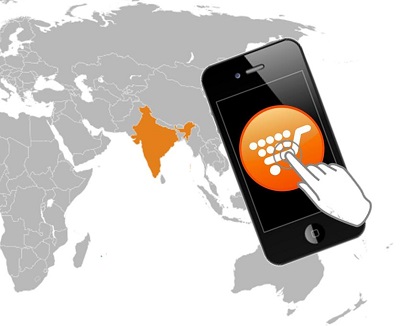In India, the vast majority of consumers are turning to m-commerce to buy their products and services online.
E-commerce has always been somewhat unpredictable in India, but Indian mobile shopping appears to be taking off with a vengeance. For instance, despite the fact that Flipkart broke the 100 million user mark two months ago, its valuation recently fell by another 38 percent.
That said, while online shopping may be somewhat unstable, mobile commerce looks much more steady.
Current Indian mobile shopping trends suggest that the market will bring in $48 billion in 2020. Furthermore, recent Regalix research indicates that 83 percent of Indian consumers prefer to use their smartphones. This makes m-commerce the most popular online shopping channel in the country.
 The same research showed that mobile commerce users in India are primarily within certain age groups. Interestingly, people between the ages of 25 and 34 years were more likely to use their smartphones to shop than those from 18 to 24 years old. In fact, 90 percent of online shoppers in that first age category prefer mobile.
The same research showed that mobile commerce users in India are primarily within certain age groups. Interestingly, people between the ages of 25 and 34 years were more likely to use their smartphones to shop than those from 18 to 24 years old. In fact, 90 percent of online shoppers in that first age category prefer mobile.
Overall, Indian mobile shopping statistics show that 1 in 3 people in the country is shopping with a smartphone.
The Regalix report showed that exactly one third – 33 percent – of shoppers in India shop over mobile commerce at least one time per month. This option provides them with a broad spectrum of options and allows for convenient price comparison no matter where the consumer happens to be.
Another 28 percent of Indian shoppers shop even more frequently than that, once per week. One in four consumers – 25 percent – shop over mobile phone at least once per three months. Only 14 percent of participants said they shopped online over their mobile devices once per year.
One noteworthy Indian mobile shopping trend pointed out by the Regalix report had to do with who was shopping. Men appeared to be using mobile phones to shop more than women. Forty four percent of women were shopping at least once per month over mobile. At the same time, 63 percent of men were buying products and services over their smartphones.
A new report showed that this technology sends more traffic into shops and could increase sales.
As shoppers increasingly look to smartphones for products in-store mobile commerce tools are having a greater impact. Brick and mortar shops that offer additional shopping assistance over mobile devices see more traffic and sales.
A recent DMI report showed that 70 percent of U.S. shoppers always or regularly use mobile devices to shop.
Still, retailers have yet to fully implement the kind of in-store mobile commerce opportunities that consumers love. This kind of m-commerce tool has the ability to raise customer engagement and in-store efficiency. Yet they are still not commonplace.
Recent research showed that shoppers want to use their mobile devices while in brick and mortar stores. More specifically, they want to be able to use smartphones as a part of self-checkout systems. They also want to be able to gain access to store inventory. When they are being assisted by a store associate, consumers want to receive alerts to tell them when their items are ready.
In-store mobile commerce tools can incentivize customers to visit shops more frequently.
 These mobile apps and other features can also encourage customers to spend larger amounts once they’re there.
These mobile apps and other features can also encourage customers to spend larger amounts once they’re there.
The DMI report provided significant insight into this trend. Among U.S. shoppers, 61 percent would visit a favorite retail shop more frequently if it had a better application. These consumers want more tools and improved value from retail apps.
Furthermore, 57 percent of shoppers said they would spend more money in-store if they had a better app to use. Another 70 percent of consumers said they would select one retailer over another based on the mobile tools they offer.
Retailers have traditionally struggled in encouraging consumers to download their mobile apps. The barriers to download include an aversion to standalone apps for every retailer they like. Moreover, many consumers don’t like the clunky functionality many apps have to offer.
However, when retailers introduce strong mobile tools, there are two strong benefits. The first benefit is enhanced user engagement. The second benefit is the chance to boost in-store foot traffic.
 The same research showed that mobile commerce users in India are primarily within certain age groups. Interestingly, people between the ages of 25 and 34 years were more likely to use their smartphones to shop than those from 18 to 24 years old. In fact, 90 percent of online shoppers in that first age category prefer mobile.
The same research showed that mobile commerce users in India are primarily within certain age groups. Interestingly, people between the ages of 25 and 34 years were more likely to use their smartphones to shop than those from 18 to 24 years old. In fact, 90 percent of online shoppers in that first age category prefer mobile.
 These mobile apps and other features can also encourage customers to spend larger amounts once they’re there.
These mobile apps and other features can also encourage customers to spend larger amounts once they’re there.